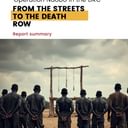A new report published on the 40th anniversary of the United Nation’s creation of the ‘abolitionist de facto’ (ADF) category, Between Retention and Abolition: Making Sense of a Death Penalty Without Executions, examines the legal, political, and symbolic role of the death penalty in countries that retain the death penalty but have either not carried out an execution in 10 years or have established an official moratorium. Authored by researchers at UK-based The Death Penalty Project and The Death Penalty Research Unit at the University of Oxford, this new report seeks to fill the existing knowledge gap about ADF status states, including examples of practices and rationales.
ADF states should be praised for the cessation of executions, but greater attention must be paid to their active contribution to the persistence of capital punishment worldwide. The ADF category remains a critical but understudied component of the global death penalty landscape. Recognising the complex, and often contradictory, functions of the death penalty in these states is essential for abolitionist efforts.
There are 42 ADF status countries, heavily concentrated in Africa (20) and the Caribbean (13). Although these countries do not carry out executions, they differ in how active their death penalty systems are across the board. Some jurisdictions continue to impose new death sentences, with some judges using the death penalty to indicate the seriousness of a crime despite knowing an execution is unlikely to be carried out. In 2024, at least 263 new death sentences were imposed in ADF status countries. 70% of ADF countries each have a death row population of at least 2,850 individuals, many of whom have been imprisoned under harsh conditions for decades, leaving lasting psychological injuries similar to those seen on death rows in retentionist states. The death penalty also serves a symbolic role, used as a tool in political discourse. For example, some politicians in ADF countries discuss expanding the death penalty to new offenses for its supposed deterrent effect, playing a key role in their “tough on crime” rhetoric. The report proposes a “competing logics” theoretical framework. For example, ADF status might emerge when a nation needs to show domestically that they are “tough on crime,” while suspending executions to avoid international criticism.
Traditionally, ADF status was seen as an indication of a nation’s progress towards abolition. However, the report notes that many abolitionist states never had ADF status, that ADF status countries have at times resumed executions, and that most nations maintain ADF status for several decades rather than moving towards abolition. The report explains that additional barriers to abolition exist in ADF status countries: with the lack of executions, the public is less likely to be aware and knowledgeable about the death penalty, meanwhile there is the “symbolic utility and political convenience” of retention. The report draws attention to the “hidden human, political and legal effects of retaining death penalty laws” and cautions that “time can be the enemy of progress.”
Daniel Cullen, Carolyn Hoyle and Parvais Jabbar, Between Retention and Abolition: Making Sense of a Death Penalty Without Executions, The Death Penalty Project, September 24, 2025;



